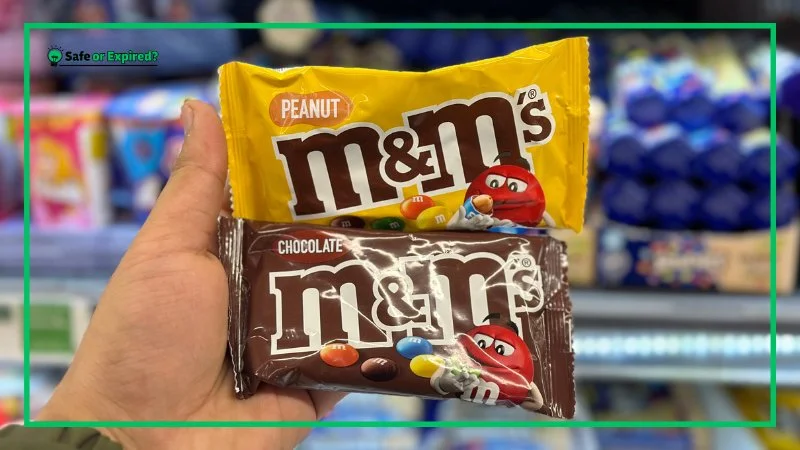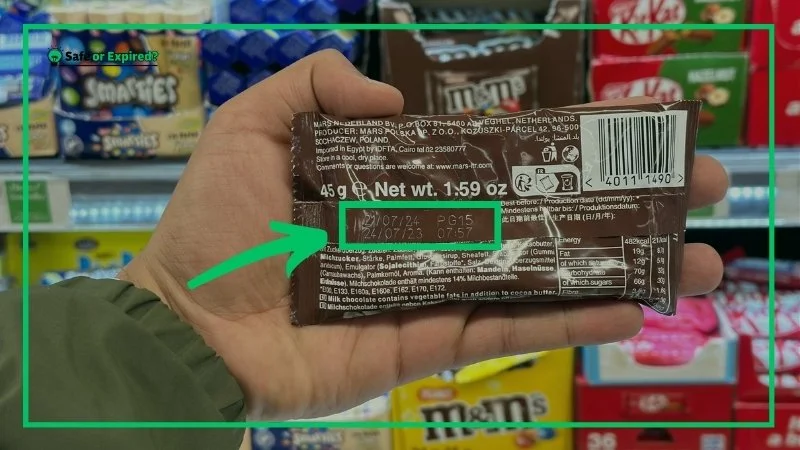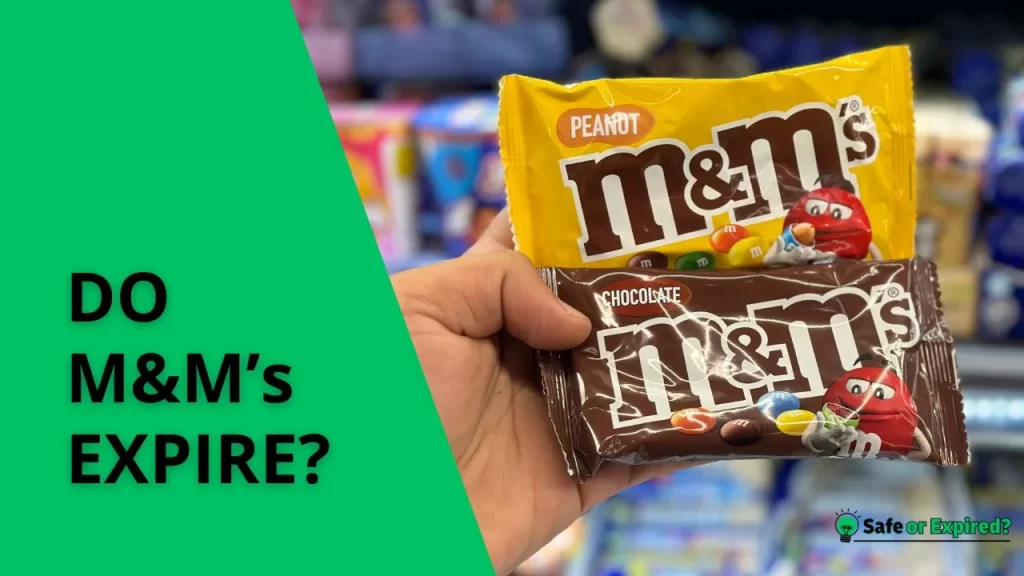Ever found a forgotten bag of M&M’s and wondered, “Do M&Ms expire?” You’re not alone! Like all good things, they come with a ‘best by’ date. But can eating expired M&M’s make you sick and how can you tell they are spoiled? Here, you will get answers to all of your questions about M&M’s expiration.
Do M&MS Expire? What You Need to Know
Yes, M&M’s do expire. Like most confectionery products, M&M’s come with a “best before” date, which indicates how long they’re expected to retain their best quality. But note that the expiration deadline varies, depending on whether you have opened the packet or not.
Wondering how long do M&Ms last unopened and opened?
Unopened vs. Opened: The Longevity of M&M’s
Generally, unopened M&M’s can last well past their “best by” date, often remaining fresh for about a year or even longer if stored properly. Keeping them in a dry place helps preserve their vibrant colors and delightful crunch.

Once opened, M&M’s start their countdown. Wondering How long do M&Ms last opened? Well, exposure to air can introduce moisture and other environmental factors that can affect the texture and taste of the candy. But don’t worry, opened M&M’s can still keep their charm for a few weeks to a month when stored correctly.
The best practice is to transfer them to an airtight container or a resealable bag. This way, you can minimize their exposure to air and moisture, keeping them just as irresistible as when you first opened them.
In both scenarios, it’s all about the storage. While M&M’s are pretty resilient thanks to their candy shell, keeping them away from heat sources is crucial. Heat can cause the chocolate inside to melt, leading to a clumpy, less enjoyable experience.
Still confused? Then, check out this table about how long do m&ms expire:
| Storage Condition | Counter (Cool, Dry Place) | Fridge |
| Opened | 2-4 weeks | 1-2 months |
| Un-Opened | 10-12 months | 12-18 months |
Note that the details are the same for the Peanut M&M expiration date.
While M&M’s have a considerable shelf life when stored properly, you might wonder about other treats in your pantry, like Jello. Interestingly, Jello’s shelf life brings up a similar curiosity. Does it last forever, or does it expire like most food items? For those who love this wiggly and sweet dessert, understanding its shelf life is crucial. Discover the answer in our detailed guide, “Does Jello Expire or Does It Stay Good Forever? (Find Out).
Now, let’s discuss more about M&Ms.
Can Expired M&M’s Make You Sick? Debunking Myths
Eating M&M’s past their “best by” date is unlikely to make you sick. While the quality, such as taste and texture, may decline, the risk of foodborne illness is low due to their low moisture and high sugar content. However, always check for signs of spoilage, like clumping, before consuming.
Nevertheless, any food product, including M&M’s, can become unsafe if it shows signs of spoilage, such as unusual odor. If the candies have been stored improperly in conditions that promote bacterial growth, like excessive moisture or heat, it may also harm you. People often ask, “Can M&Ms mold?” Yes, and it’s wise to be cautious if you see it.
If your M&M’s have been exposed to moisture and display any mold signs, discarding them is the safest option. Always inspect long-stored candies to ensure they’re still fit for consumption.
How to Tell If M&Ms Have Gone Bad? Reading the Signs
To tell if M&M’s has gone bad, you should first smell them. If you smell any unusual odor, it means they have gone bad. If you also see discoloration or mold, it means you should discard them. Furthermore, packaging integrity and clumping are also other signs that the M&M’s are spoiled.
Unusual Odor
One of the first signs that your M&M’s might have gone bad is an off-smell. While M&M’s generally don’t have a strong odor, any unusual smells can indicate that they’ve absorbed odors from their environment or, in rare cases, have begun to spoil.
Discoloration or Bloom
If you notice the colors of your M&M’s looking faded or if there’s a white, powdery substance on the shell, this could be a sign of “bloom.” Bloom occurs when the fats or sugars in the chocolate separate due to temperature changes. While bloom doesn’t necessarily mean the M&M’s are unsafe to eat, it can affect texture and taste.
Texture Changes
M&M’s should have a crisp shell and a somewhat soft interior. If the shell is sticky or slimy, or the chocolate inside feels gritty or too hard, this could indicate that they’ve been exposed to moisture or have otherwise degraded.
Clumping Together
Properly stored M&M’s should flow freely from their bag. If you find that they’re clumped together, this is a sign they’ve been exposed to moisture. Clumping can make it difficult to tell if any individual candies have other signs of spoilage.
It’s worth noting that other candies face similar challenges. Starburst, with its chewy texture and fruity flavors, is another treat that might leave you questioning its durability over time. How does its shelf life compare, and what are the best ways to ensure it remains enjoyable? Unwrap the details in our article “Do Starburst Expire? (Unwrapping the Truth About Shelf Life)”.
Examine the Package
Lastly, check the packaging. If the bag is torn or damaged, especially if there are holes, it could have allowed pests or contaminants inside. Compromised packaging can lead to spoilage or contamination, making the M&M’s unsafe to eat.
Furthermore, the expiration date on it is like a deadline. The candies will retain the original taste until this date. Therefore, always check the M&M’s package and the expiration date before you make a purchase.

While M&M’s are unlikely to spoil in a way that makes them harmful, these signs can indicate that they’re not at their peak quality. When in doubt, trust your senses; if something seems off, it’s best to discard them.
How to Store M&M’s Properly To Increase The Shelf Life?
To properly store M&M’s to increase their shelf life, focus on where you keep them. A cool and dry place is ideal, as moisture and heat can spoil them. Refrigeration is another option but avoid freezing. You should also keep M&M’s in an airtight container to maintain their quality.
Keep Them in a Cool, Dry Place
The ideal storage spot for M&M’s is somewhere cool and dry. High temperatures/heat can cause the chocolate to melt, leading to a sticky mess, while humidity can affect the candy shell’s crispness.
A pantry or cupboard away from sun rays or heat sources is perfect.
Use Airtight Containers
Once opened, transferring M&M’s to an airtight container can help protect them from moisture and keep them fresh longer. Airtight containers also prevent the candies from absorbing any odors from other foods stored nearby.
Refrigeration Is an Option
If you live in a particularly warm or humid environment, you might wonder, “Do M&Ms go bad if left out?” In such cases, storing them in the refrigerator can help prevent melting. Just be sure to bring them to room temperature before enjoying them to avoid condensation, which can spoil the texture.
Avoid Freezing
While freezing M&M’s won’t necessarily harm them, it can affect the texture and cause sugar bloom (when they’re thawed). If you do choose to freeze them, ensure they’re in a well-sealed bag or container to prevent moisture ingress.
Keep Them Away from Strong Odors
Chocolate can absorb odors, so it’s crucial to store M&M’s away from strongly scented foods or substances. This precaution helps ensure that the candy retains its original flavor without picking up any unwanted tastes.
People often ask, “How long do M&Ms last after expiration date if stored properly?” M&M’s can last beyond their expiration date, typically remaining safe to consume for several months if stored properly (often up to 6-12 months).
Conclusion
Throughout this article, you learned important aspects of M&Ms’ longevity, including how long do M&Ms last unopened, can expired M&Ms make you sick, and do M&Ms go bad if left out. Here are the key takeaways to ensure your M&Ms remain a delightful snack:
- M&M’s do expire, but they have a generous shelf life, easily lasting beyond their ‘best by’ date when stored properly.
- Expired M&M’s rarely cause sickness but might lose their signature crunch and flavor.
- Proper storage is crucial, ideally in a cool, dry place, to maintain their quality.
Remember, the key to prolonging their shelf life lies in how they are stored. So next time you stumble upon a bag of M&M’s, you’ll know exactly how to ensure they’re still good to enjoy.

